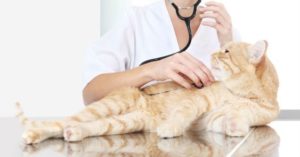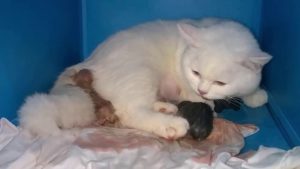Cats are lovely creatures that make wonderful pets. If you’re a cat owner, you would know how important it is to take care of them, especially when they are about to give birth. Knowing the signs that your cat is about to go into labor can help prepare you and ensure a safe delivery for your furry friend. In this article, we will discuss the different signs that your cat is about to give birth, what to expect during labor, and how to care for your cat before and after giving birth.

Signs of Labor
Physical Appearance
One of the first signs that you may notice when your cat is about to give birth is a change in her physical appearance. During pregnancy, a cat’s nipples will become enlarged. As your cat gets closer to labor, her belly will begin to noticeably drop, indicating that the kittens are moving into position. You may also notice that your cat’s vulva has become swollen and that she is licking herself more often.
Nesting Behaviors
In the days leading up to delivery, you may notice that your cat has started to display nesting behaviors. Your cat may begin to search for a quiet, dark, and warm place to give birth. She may start to scratch at surfaces or rearrange bedding in preparation for labor. It’s essential to provide your cat with a comfortable and warm area where she feels secure during delivery.
Changes in Behavior

As labor approaches, you may notice that your cat’s behavior has changed. Some cats become more vocal and meow frequently. Others become more affectionate or clingy and may follow their owners around the house. On the other hand, some cats may become restless and agitated, pacing around the room or hiding in unusual places. These changes in behavior are normal and indicate that your cat is getting ready to give birth.
Stages of Labor
Once your cat begins to give birth, it’s essential to monitor her closely and ensure that she is comfortable throughout the process. Labor generally occurs in three stages.
Stage One
During the first stage of labor, your cat may become restless and agitated. She may pant, vomit, or excessively groom herself. You may also notice that she has a decreased appetite. The first stage of labor can last up to 24 hours, but on average, it lasts between six to twelve hours.
Stage Two
The second stage of labor is when your cat actively starts giving birth. During this phase, you will see your cat pushing and straining as the kittens start to come out. The kittens are usually delivered within fifteen minutes of each other, but it’s normal for there to be a break of several hours between kittens. If your cat appears to be struggling for more than an hour without delivering a kitten, call your veterinarian immediately.
Stage Three
The third stage of labor is the delivery of the placenta. After each kitten is born, the placenta will follow within ten to thirty minutes. It’s important to keep track of the number of placentas to ensure that your cat delivers all of them. Retained placentas can cause infections and complications that may harm both the mother and the kittens.
Caring for Your Cat After Giving Birth

After giving birth, your cat will need extra care and attention. Here are some tips for caring for your cat after delivery:
Maintain a Quiet Environment
Ensure that the area where your cat gave birth is quiet and safe. Make sure that the temperature is warm enough, but not too hot. Keep other pets and children away from the area, as your cat needs time to rest and bond with her kittens.
Monitor Your Cat’s Health
Keep an eye on your cat’s health after delivery. Watch for any signs of infection, such as a fever or discharge from the vagina. Ensure that your cat is eating and drinking enough and that she is passing urine and feces regularly.
Monitor the Kittens
Monitor the kittens closely after birth. Ensure that they are nursing and gaining weight. Watch for any signs of illness or weakness. If you notice anything unusual, contact your veterinarian immediately.

Conclusion
Being aware of the signs that your cat is about to give birth is crucial for ensuring a safe and comfortable experience for both the mother cat and her newborn kittens. By observing physical changes, nesting behaviors, and shifts in your cat’s behavior, you can prepare a suitable environment for the upcoming delivery. Understanding the three stages of labor and providing proper postpartum care will also contribute to the well-being of the mother and her kittens. Remember to monitor their health, seek veterinary assistance when needed, and enjoy witnessing the precious moments of new life.